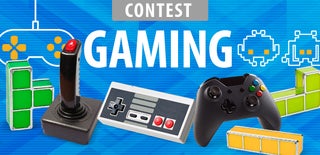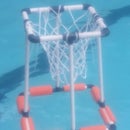Introduction: Super Cheap Arcade Cabinet
Inspired by many other Instructables, I decided to make my own arcade machine. Most of them use Raspberry Pi, but I am a complete noob when it comes to that and I'm on a teenager budget. Luckily for me, we happened to have an old MacBook sitting around collecting dust that works fine. If you have some of the tools and materials sitting around (i.e. computer, plywood, monitor) then the whole project should cost you less than forty bucks.
Step 1: Get the Games
*DISCLAIMER* I do not support or encourage piracy of any sort, so don't download games that you don't own. Alright, now that the legal issues are out of the way, you need to get games to play on the cabinet you're building. I suggest OpenEmu for Mac computers since it has multiple emulators in one well organized program (what I used). For Windows, you have to find your own emulators, but digitaltrends has a good list here. http://www.digitaltrends.com/gaming/best-emulators...
If you do go with OpenEmu, I highly suggest downloading the experimental version, which just gives access to more emulators that don't work completely perfectly yet, like arcade.
Step 2: Materials
*means optional but recommended
Parts you will need:
- Computer or laptop, preferably a small computer like Mac Mini
- A monitor with a video cable that your computer can accept
- A mouse
- Lots of plywood
- lots of 1" screws
- 4-6 one inch machine screws
- two 6" L brackets (Home Depot is the best place to find them)
- small door hinge*
- Speakers* (depending on what kind of computer you use)
- Probably the most important, the joystick and buttons. You will also need an encoder to plug it into the computer. I highly recommend the Zero Delay Arcade Encoder, it's the cheapest on the market and it works perfectly. Mine came with the arcade controls I ordered from here and it works perfectly. http://www.ebay.com/itm/Zero-Delay-USB-Encoder-To-...
- 2 cans of semigloss black Rustoleum spraypaint, or any other color that you want
- small screw-in door handle
Software:
- For the the frontend/emulator I used http://openemu.org/. In my opinion it's the best one out there because it combines multiple emulators an organizes it very well. You will want to download the experimental version to get emulators like MAME arcade and N64.
Tools:
- circular saw or other saw (if you don't have a powered saw, this will take much longer)
- drill
- 1" hole saw/spade drill bit and 30 mm hole saw/spade drill bit (these measurements are for the buttons I got, yours will probably be different measurements than mine if you don't buy the same kit. I recommend checking the product specs on the page you got it)
- 2" hole saw bit
- hot glue gun*
- safety goggles
- noise cancelling earmuffs*
- belt sander (if you don't have it then just hope that you don't make any mistakes)
- jigsaw or hand saw
- angle clamp or hand clamps
NOTE: most of the 'fancy tools' like a belt sander or an angle clamp can be replaced with some elbow grease and hand tools, but they make the job a lot easier
Step 3: Measurements
Once you've collected your tools and materials, you need to measure the plywood. Above I have measurements as well as (not) very amazing drawings of what it should look like in my notebook. Note that when you are measuring out front you need to cut out two bits in the corners so the control board can fit. See the picture for reference. For the back and sides, my dad and I went to Home Depot to get more plywood. There's more about that in the next step.
Step 4: Cut the Wood
Now that you have measured all of the wood, it's time to cut it. If you have a table saw, I highly recommend using it for this, but if you have a circular saw you will need to make a guide. How to make a guide: http://www.popularmechanics.com/home/tools/review...
We went to Home Depot to get the wood to the back and sides, and they also cut the wood for us there. If you use the exact same measurements as I did, then you will use the whole width of the board, which is 48", and then you'll have a bunch of scrap left over for smaller parts.
Step 5: Control Panel Setup
Now we need to drill out the holes for the buttons and joystick. The diameter of the buttons I got was 30mm, and the small ones were an inch. Unfortunately, I couldn't find a 30mm hole saw or anything like that, so I went a tiny bit smaller. Once you get the drill bits and find a way to mark out where to drill, then get to work drilling. Since the buttons were slightly too big, I had to go to work with a wood rasp and it was a pain in the butt, so I highly recommend using the right size bit if you have access to it. As you are shaving out the button holes, test to see if the buttons fit every once in a while so you don't make it too big. Next, find out where you want to put the joystick. Don't go too close to the edge, or you won't be able to screw it in. Then put on the 2" hole saw drill bit and drill all the way through. I used 2" because it gave plenty of room for moving the joystick, but it doesn't overlap with the screws. Now, take the buttons out, because it's time to paint!
Step 6: Painting It
Since I am not a professional artist and probably never will be, I decided to go with the tried and true method of painting it all black. If you want to give it some pizzazz, then you might want to use different colored acrylic paint and a brush instead of spray paint. To ensure less scuffing and better quality, use a couple coats of paint.
Step 7: Assembly: Part 1
Now comes the fun part where your hard earned creation comes to life. I decided to start with the bottom piece since that will hold everything together. First I connected it to the front piece by clamping them both down and drilling in screws (of course with a bunch of boring stuff in between like measuring and drilling pilot holes. zzzzzz...) If you actually followed steps 2 and 3, you should have cut out two divots in the front piece. You will need the spaces in a few steps. Next, attach the back piece in the same way as you did the front. Now it's time to put in the shelf for the laptop and monitor. If you're using the exact same measurements as I am, then the shelf will be 32 inches up from the ground or 7 inches down from the top of the front panel. Finally, install one of the side boards, but save the other one.
NOTE: If you made any slight measuring or cutting errors like I did (i.e. 1/16" too big) and the boards are not flush a belt sander will be you best friend. Above are a before and after belt sanding from when two boards weren't flush.
Step 8: Wiring the Controls
Before we close up the cabinet, put the buttons in their respective slots and wire them up to the encoder. Next, we need to put the joystick in. I decided to have the joystick come up from inside since the bottom of it would be too complicated to cut out in the wood. First mark out where the holes are to drill. Use a drill bit smaller than the screws you are using and once the holes are made put in the screws and tighten them.
Step 9: Cable Holes
Now it's time to drill holes so the cables can get to the wall. Use the " drill bit in one corner of the 'shelf' for the monitor and another one in the middle of where the control panel will go.
Step 10: Maintenance Door
This is so we can put in the laptop and also get new games, turn it on after a power outage, etc. First mark out the area to cut, them drill a small hole so you can start cutting with the jigsaw. Then drill the holes for the hinge above the cut out area and screw it in, then install the knob. Finally once you've cut out the door, put the laptop and everything you need inside and install the door.
Step 11: Finish the Control Panel
First I put the protruding parts of the control panel into the divots I cut, and then screwed it into the cabinet. I used two L-brackets to support the entire thing, and the encoder thingy went inside the control panel with the wire snaking down to the computer.
Step 12: Connect the Computer
Now all you have to do is put the computer into the cabinet through the maintenance door and snake out the cables. Then put the monitor inside of the cabinet and make sure all the wires fit. I had to use an old plastic box under the monitor to give it a boost, because it was too low at first. I would suggest moving the cabinet to where you want to keep it before you put everything in though, so you don't have to lug extra weight up stairs (if that's where you're bringing it).
Step 13: Relive Your Childhood!
Or at least what you had wished for when you were a kid...
Thanks for sticking with me for this whole thing, this instructable took a long time to make, so I'd appreciate any favorites or votes! I have more projects on the way, so keep your eyes open for more projects.

Participated in the
Gaming Contest











